ManagedEngine ServiceDesk Plus (Zoho) Connector for SSAS
ManagedEngine (Zoho) ServiceDesk Plus Connector can be used to integrate ServiceDesk Plus data in your App / BI Tools. You can read/write Requests, Tasks, Comments, Worklogs and many other items.
In this article you will learn how to quickly and efficiently integrate ManagedEngine ServiceDesk Plus (Zoho) data in SSAS without coding. We will use high-performance ManagedEngine ServiceDesk Plus (Zoho) Connector to easily connect to ManagedEngine ServiceDesk Plus (Zoho) and then access the data inside SSAS.
Let's follow the steps below to see how we can accomplish that!
ManagedEngine ServiceDesk Plus (Zoho) Connector for SSAS is based on ZappySys API Driver which is part of ODBC PowerPack. It is a collection of high-performance ODBC drivers that enable you to integrate data in SQL Server, SSIS, a programming language, or any other ODBC-compatible application. ODBC PowerPack supports various file formats, sources and destinations, including REST/SOAP API, SFTP/FTP, storage services, and plain files, to mention a few.
Create Data Source in ZappySys Data Gateway based on API Driver
-
Download and install ODBC PowerPack.
-
Search for gateway in start menu and Open ZappySys Data Gateway:

-
Go to Users Tab to add our first Gateway user. Click Add; we will give it a name tdsuser and enter password you like to give. Check Admin option and click OK to save. We will use these details later when we create linked server:

-
Now we are ready to add a data source. Click Add, give data source a name (Copy this name somewhere, we will need it later) and then select Native - ZappySys API Driver. Finally, click OK. And it will create the Data Set for it and open the ZS driver UI.
ManagedengineServicedeskPlusZohoDSN

-
When the Configuration window appears give your data source a name if you haven't done that already, then select "ManagedEngine ServiceDesk Plus (Zoho)" from the list of Popular Connectors. If "ManagedEngine ServiceDesk Plus (Zoho)" is not present in the list, then click "Search Online" and download it. Then set the path to the location where you downloaded it. Finally, click Continue >> to proceed with configuring the DSN:
ManagedengineServicedeskPlusZohoDSNManagedEngine ServiceDesk Plus (Zoho)
-
Now it's time to configure the Connection Manager. Select Authentication Type, e.g. Token Authentication. Then select API Base URL (in most cases, the default one is the right one). More info is available in the Authentication section.
ManagedEngine ServiceDesk Plus (Zoho) authentication
OAuth Connection for ManageEngine ServiceDesk Plus API [API reference]
To register custom App, perform the following steps (Detailed steps found in the help link at the end)- Go to Zoho API Console
- Click Add Client link
- Select Server-based Applications option
- Enter desired client name (Display purpose only)
- Enter some URL for Company homepage
- For Authorized Redirect URI enter https://zappysys.com/oauth (Or enter your own but we recommend using ZappySys one if possible). This URL must match on Zoho Connector UI.
- Click CREATE.
- Copy Client ID and Secret and paste on Zoho Connector UI.
API Connection Manager configuration
Just perform these simple steps to finish authentication configuration:
-
Set Authentication Type to
OAuth [OAuth] - Optional step. Modify API Base URL if needed (in most cases default will work).
- Fill in all the required parameters and set optional parameters if needed.
- Press Generate Token button to generate the tokens.
- Finally, hit OK button:
ManagedengineServicedeskPlusZohoDSNManagedEngine ServiceDesk Plus (Zoho)OAuth [OAuth]https://sdpondemand.manageengine.com/api/v3Optional Parameters ClientId ClientSecret Permissions SDPOnDemand.requests.ALL AccountUrl https://accounts.zoho.com RedirectUrl https://zappysys.com/oauth RetryMode RetryWhenStatusCodeMatch RetryStatusCodeList 429 RetryCountMax 5 RetryMultiplyWaitTime True 
-
Once the data source connection has been configured, it's time to configure the SQL query. Select the Preview tab and then click Query Builder button to configure the SQL query:
 ZappySys API Driver - ManagedEngine ServiceDesk Plus (Zoho)ManagedEngine (Zoho) ServiceDesk Plus Connector can be used to integrate ServiceDesk Plus data in your App / BI Tools. You can read/write Requests, Tasks, Comments, Worklogs and many other items.ManagedengineServicedeskPlusZohoDSN
ZappySys API Driver - ManagedEngine ServiceDesk Plus (Zoho)ManagedEngine (Zoho) ServiceDesk Plus Connector can be used to integrate ServiceDesk Plus data in your App / BI Tools. You can read/write Requests, Tasks, Comments, Worklogs and many other items.ManagedengineServicedeskPlusZohoDSN
-
Start by selecting the Table or Endpoint you are interested in and then configure the parameters. This will generate a query that we will use in SSAS to retrieve data from ManagedEngine ServiceDesk Plus (Zoho). Hit OK button to use this query in the next step.
SELECT * FROM Requests Some parameters configured in this window will be passed to the ManagedEngine ServiceDesk Plus (Zoho) API, e.g. filtering parameters. It means that filtering will be done on the server side (instead of the client side), enabling you to get only the meaningful data
Some parameters configured in this window will be passed to the ManagedEngine ServiceDesk Plus (Zoho) API, e.g. filtering parameters. It means that filtering will be done on the server side (instead of the client side), enabling you to get only the meaningful datamuch faster . -
Now hit Preview Data button to preview the data using the generated SQL query. If you are satisfied with the result, use this query in SSAS:
 ZappySys API Driver - ManagedEngine ServiceDesk Plus (Zoho)ManagedEngine (Zoho) ServiceDesk Plus Connector can be used to integrate ServiceDesk Plus data in your App / BI Tools. You can read/write Requests, Tasks, Comments, Worklogs and many other items.ManagedengineServicedeskPlusZohoDSN
ZappySys API Driver - ManagedEngine ServiceDesk Plus (Zoho)ManagedEngine (Zoho) ServiceDesk Plus Connector can be used to integrate ServiceDesk Plus data in your App / BI Tools. You can read/write Requests, Tasks, Comments, Worklogs and many other items.ManagedengineServicedeskPlusZohoDSNSELECT * FROM Requests You can also access data quickly from the tables dropdown by selecting <Select table>.A
You can also access data quickly from the tables dropdown by selecting <Select table>.AWHEREclause,LIMITkeyword will be performed on the client side, meaning that thewhole result set will be retrieved from the ManagedEngine ServiceDesk Plus (Zoho) API first, and only then the filtering will be applied to the data. If possible, it is recommended to use parameters in Query Builder to filter the data on the server side (in ManagedEngine ServiceDesk Plus (Zoho) servers). -
Click OK to finish creating the data source.
-
Most Important Step: Now, After creating or modifying a data source in ZappySys Data Gateway, make sure to click the SAVE button to preserve your changes.
Then, RESTART the Data Gateway service to ensure all changes are properly applied.Skipping either step may result in the new settings not taking effect.

Read ManagedEngine ServiceDesk Plus (Zoho) data in SSAS cube
With the data source created in the Data Gateway (previous step), we're now ready to read ManagedEngine ServiceDesk Plus (Zoho) data in an SSAS cube. Before we dive in, open Visual Studio and create a new Analysis Services project. Then, you're all set!
Create data source based on ZappySys Data Gateway
Let's start by creating a data source for a cube, based on the Data Gateway's data source we created earlier. So, what are we waiting for? Let's do it!
-
Create a new data source:
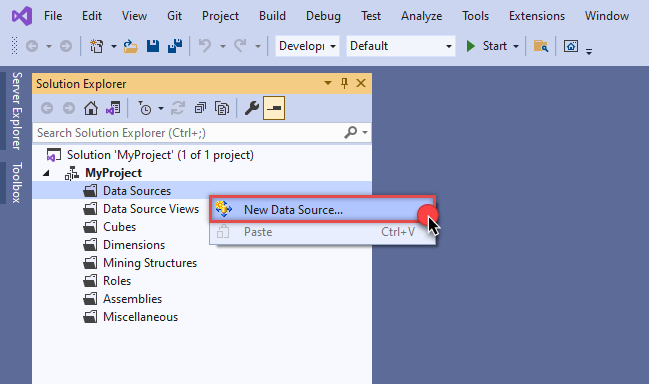
-
Once a window opens,
select Create a data source based on an existing or new connection option and
click New...:
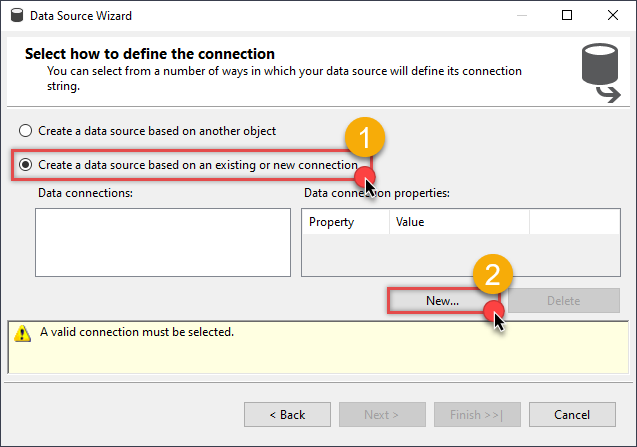
-
Here things become a little complicated, but do not despair, it's only for a little while.
Just perform these little steps:
- Select Native OLE DB\SQL Server Native Client 11.0 as provider.
- Enter your Server name (or IP address) and Port, separated by a comma.
- Select SQL Server Authentication option for authentication.
- Input User name which has admin permissions in the ZappySys Data Gateway.
- In Database name field enter the same data source name you use in the ZappySys Data Gateway.
- Hopefully, our hard work is done, when we Test Connection.
ManagedengineServicedeskPlusZohoDSNManagedengineServicedeskPlusZohoDSN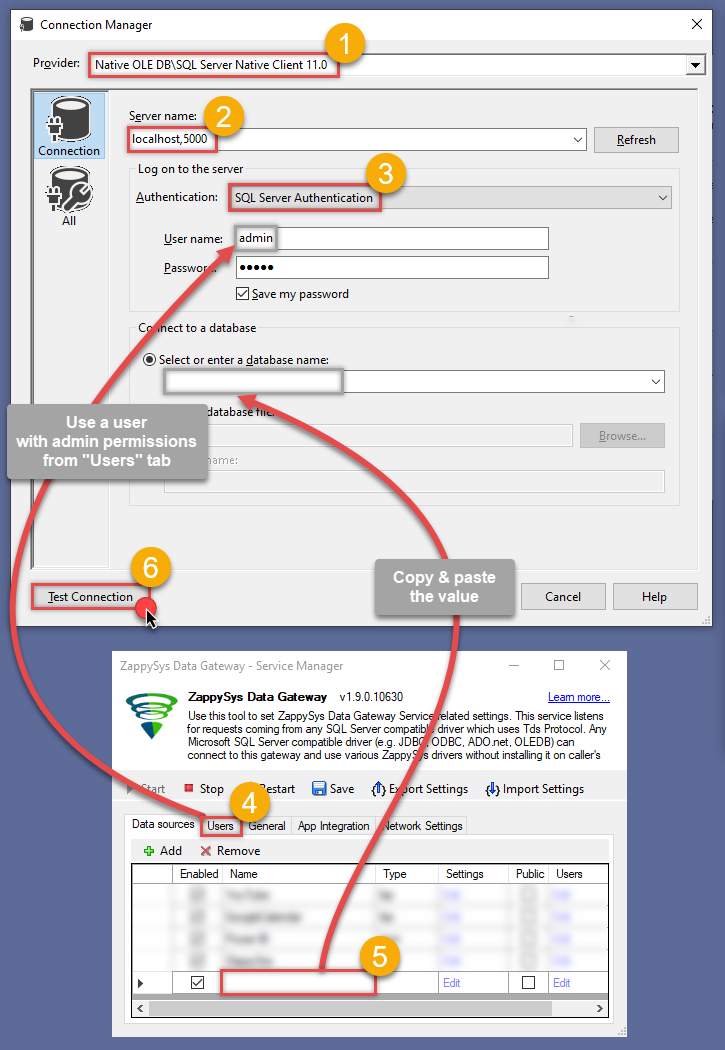 If SQL Server Native Client 11.0 is not listed as Native OLE DB provider, try using these:
If SQL Server Native Client 11.0 is not listed as Native OLE DB provider, try using these:- Microsoft OLE DB Driver for SQL Server
- Microsoft OLE DB Provider for SQL Server
-
Indeed, life is easy again:

Add data source view
We have data source in place, it's now time to add a data source view. Let's not waste a single second and get on to it!
-
Start by right-clicking on Data Source Views and then choosing New Data Source View...:
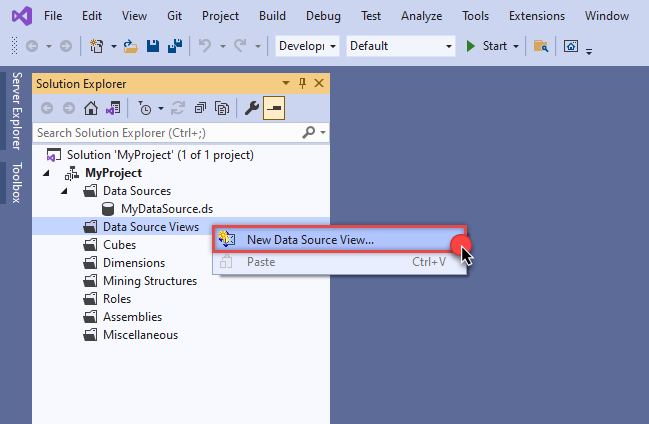
-
Select the previously created data source and click Next:

- Ignore the Name Matching window and click Next.
-
Add the tables you will use in your SSAS cube:
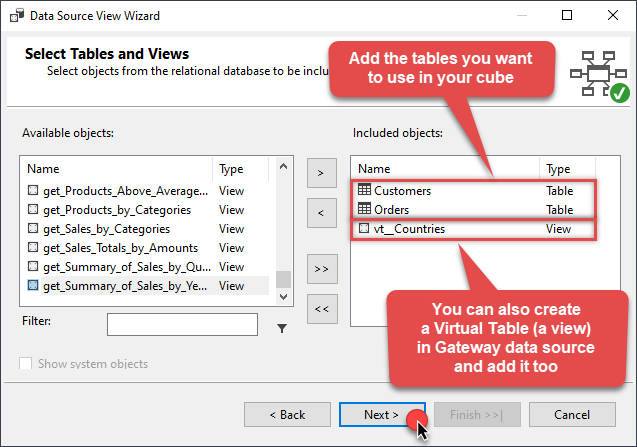 For cube dimensions, consider creating a Virtual Table in the Data Gateway's data source. Use the
For cube dimensions, consider creating a Virtual Table in the Data Gateway's data source. Use theDISTINCTkeyword in theSELECTstatement to get unique values from the facts table, like this:SELECT DISTINCT Country FROM CustomersFor demonstration purposes we are using sample tables which may not be available in ManagedEngine ServiceDesk Plus (Zoho). -
Review your data source view and click Finish:

-
Add the missing table relationships and you're done!
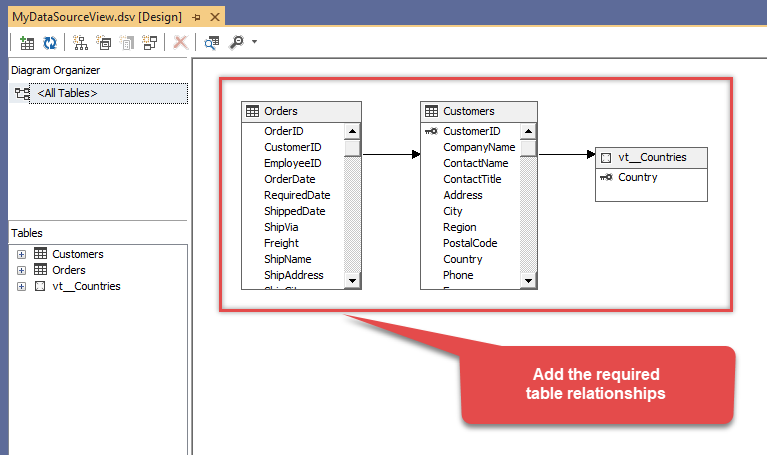
Create cube
We have a data source view ready to be used by our cube. Let's create one!
-
Start by right-clicking on Cubes and selecting New Cube... menu item:
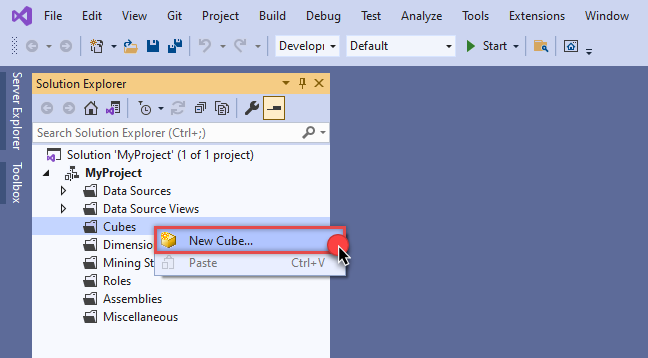
-
Select tables you will use for the measures:
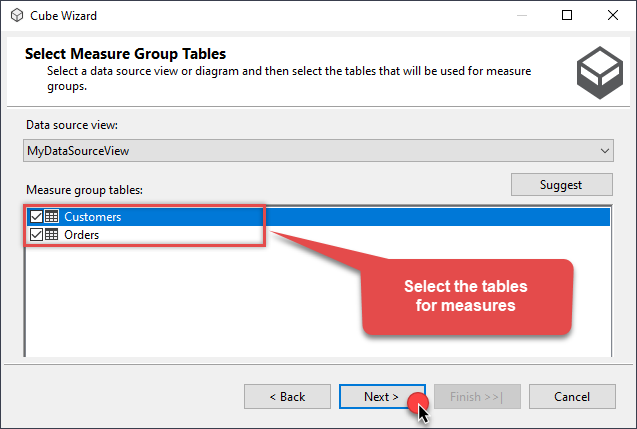
-
And then select the measures themselves:
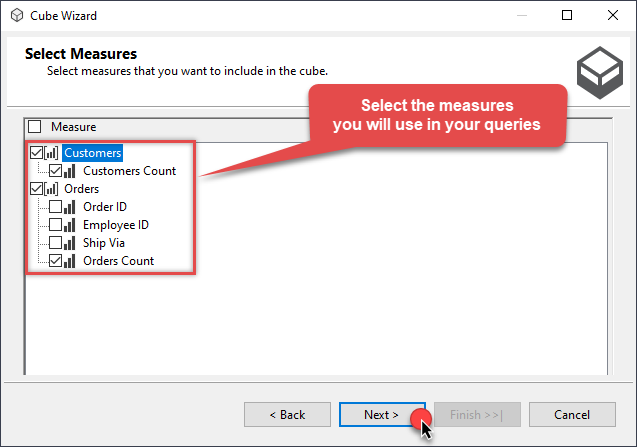
-
Don't stop and select the dimensions too:
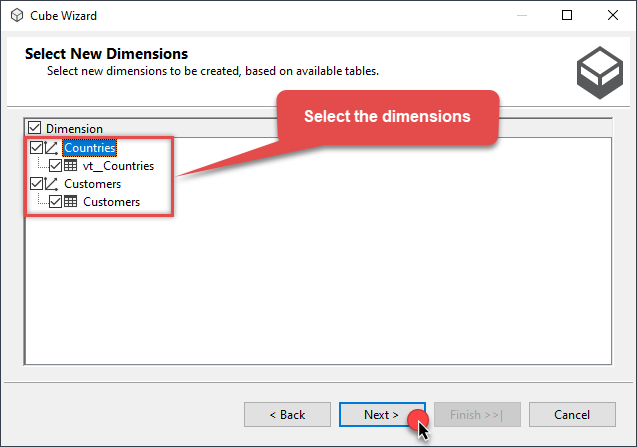
-
Move along and click Finish before the final steps:
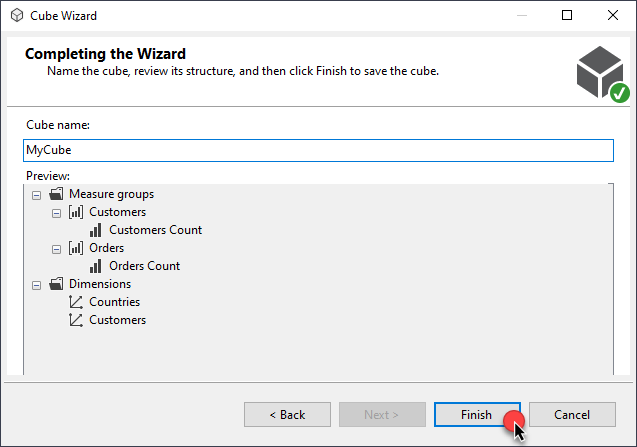
-
Review your cube before processing it:
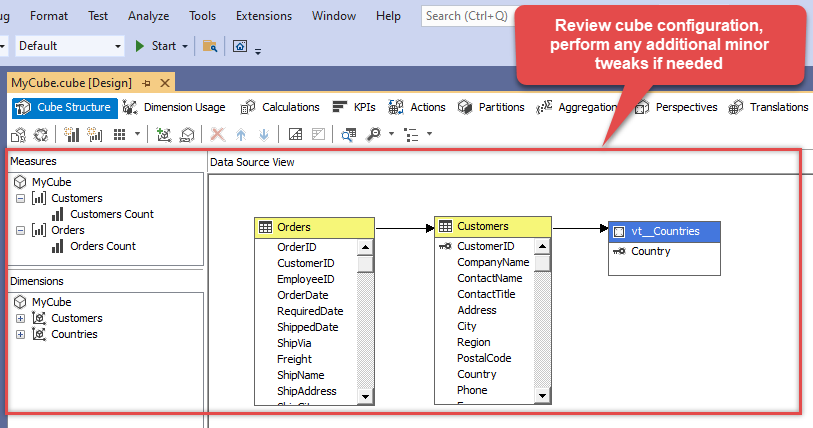
-
It's time for the grand finale! Hit Process... to create the cube:
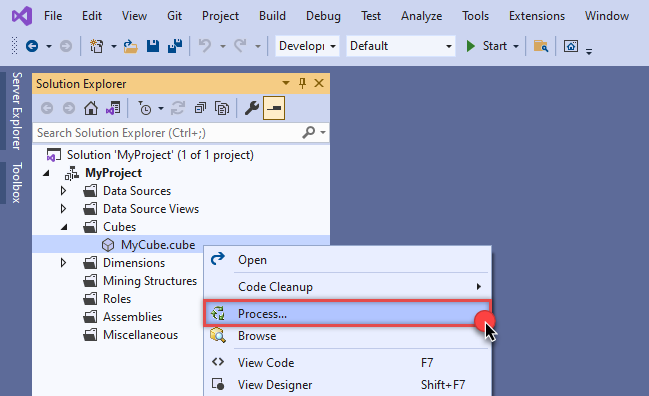
-
A splendid success!
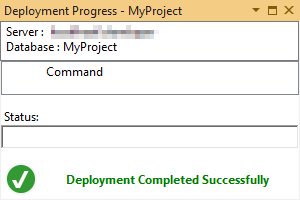
Execute MDX query
The cube is created and processed. It's time to reap what we sow! Just execute an MDX query and get ManagedEngine ServiceDesk Plus (Zoho) data in your SSAS cube:
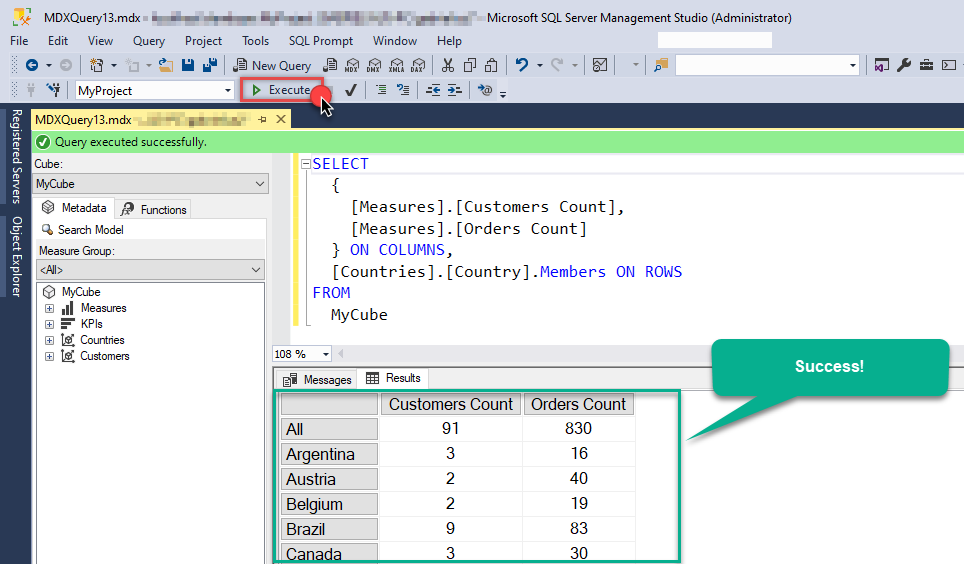
Actions supported by ManagedEngine ServiceDesk Plus (Zoho) Connector
Learn how to perform common ManagedEngine ServiceDesk Plus (Zoho) actions directly in SSAS with these how-to guides:
- Delete Request
- Get Asset Details
- Get Assets
- Get Change Details
- Get Change Note Details
- Get Change Notes
- Get Change Task Comment Details
- Get Change Task Comments
- Get Change Task Details
- Get Change Task Worklog Details
- Get Change Task Worklogs
- Get Change Tasks
- Get Change Worklog Details
- Get Change Worklogs
- Get Changes
- Get Contract Details
- Get Contracts
- Get Problem Details
- Get Problem Note Details
- Get Problem Notes
- Get Problem Task Comment Details
- Get Problem Task Comments
- Get Problem Task Details
- Get Problem Task Worklog Details
- Get Problem Task Worklogs
- Get Problem Tasks
- Get Problem Worklog Details
- Get Problem Worklogs
- Get Problems
- Get Project Details
- Get Project Members
- Get Project Milestone Tasks
- Get Project Milestones
- Get Project Note Details
- Get Project Notes
- Get Project Task Comment Details
- Get Project Task Comments
- Get Project Task Details
- Get Project Task Worklog Details
- Get Project Task Worklogs
- Get Project Tasks
- Get Project Worklog Details
- Get Project Worklogs
- Get Projects
- Get Purchase Order Details
- Get Purchase Orders
- Get Release Details
- Get Release Note Details
- Get Release Notes
- Get Release Task Comment Details
- Get Release Task Comments
- Get Release Task Details
- Get Release Task Worklog Details
- Get Release Task Worklogs
- Get Release Tasks
- Get Release Worklog Details
- Get Release Worklogs
- Get Releases
- Get Request Details
- Get Request Note Details
- Get Request Notes
- Get Request Task Comment Details
- Get Request Task Comments
- Get Request Task Details
- Get Request Task Worklog Details
- Get Request Task Worklogs
- Get Request Tasks
- Get Request Worklog Details
- Get Request Worklogs
- Get Requests
- Get Task Details
- Get Tasks
- Test Connection
- Make Generic API Request
- Make Generic API Request (Bulk Write)
Conclusion
In this article we showed you how to connect to ManagedEngine ServiceDesk Plus (Zoho) in SSAS and integrate data without any coding, saving you time and effort.
We encourage you to download ManagedEngine ServiceDesk Plus (Zoho) Connector for SSAS and see how easy it is to use it for yourself or your team.
If you have any questions, feel free to contact ZappySys support team. You can also open a live chat immediately by clicking on the chat icon below.
Download ManagedEngine ServiceDesk Plus (Zoho) Connector for SSAS Documentation











































































